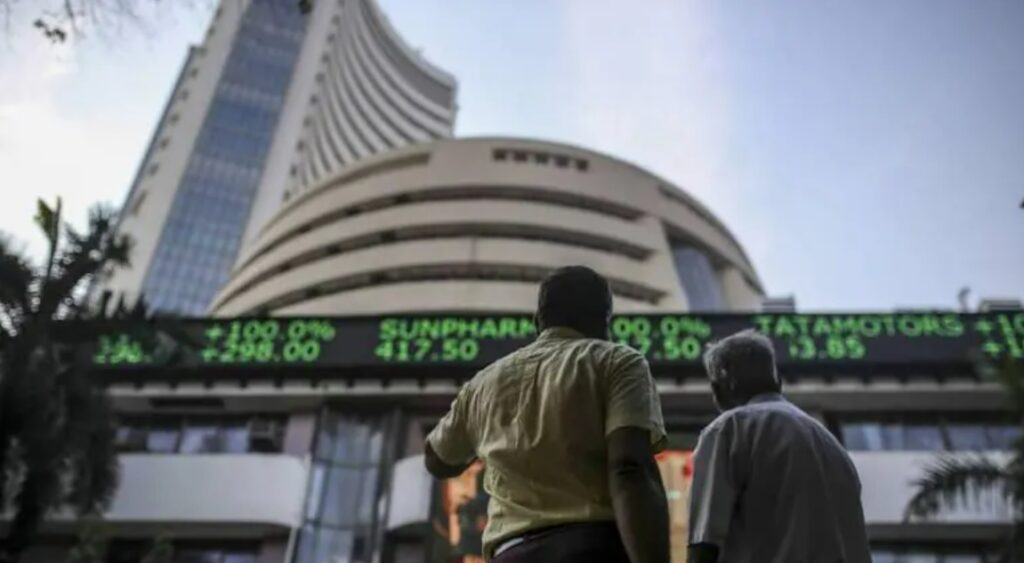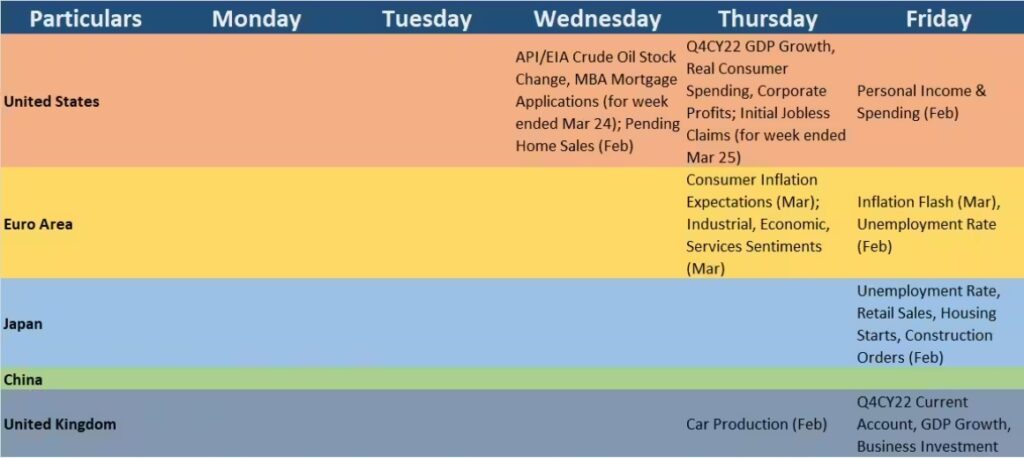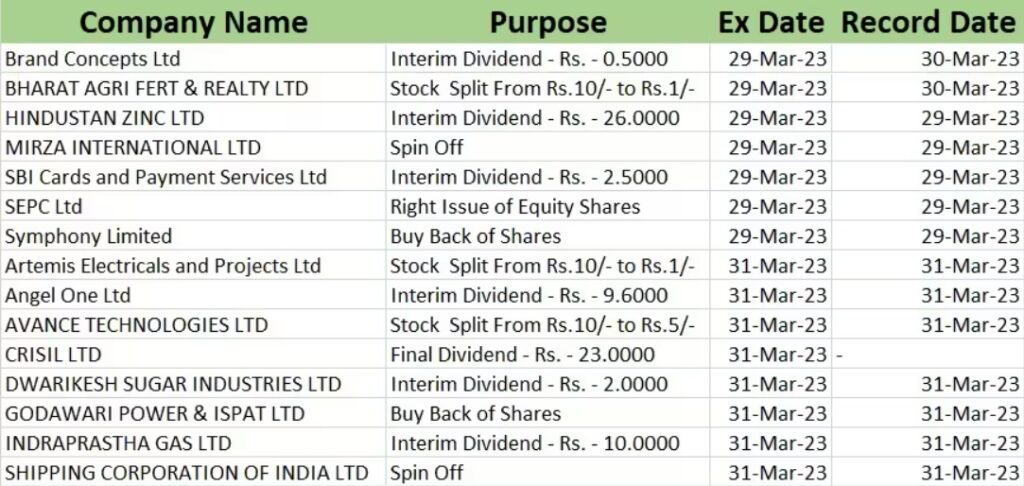According to experts, the global banking system is expected to remain the focus in the coming week, as there are no significant driving factors on the domestic front. As a result, the market is anticipated to experience both volatility and range-bound trading during the holiday-shortened week.

During the week ending on March 24, the market experienced a nearly 1 percent drop, marking the third consecutive week of a downtrend. The negative sentiment was driven by a correction in European banking stocks following rate hikes by the European Central Bank, as well as consistent selling by foreign institutional investors (FIIs) and an unexpected increase in the securities transaction tax (STT) on futures and options trades by the government. As a result, the BSE Sensex decreased by 0.8 percent, closing at 57,527, while the Nifty50 declined by 0.91 percent, reaching its lowest weekly closing level since July 2022 at 16,945. Notably, technology, auto, metal, and realty stocks saw the most correction, while FMCG and pharma sectors outperformed the benchmarks.
During the week, the Nifty midcap 100 index and the smallcap 100 index both experienced a decline of 1.75 percent and 1.88 percent, respectively, resulting in the broader market being hit harder than the benchmarks. As a result, the market closed at its lowest levels since July 2022.
Experts predict that the upcoming week, which is shortened due to the holiday, will be characterized by volatile and rangebound trading. They believe that the global banking system will be the focus of attention in the absence of significant domestic driving factors. According to Vinod Nair, Head of Research at Geojit Financial Services, the market is expected to remain volatile in the short term as the global banking system, particularly in Europe, has yet to fully recover from the crisis.
In the upcoming week, the hard money policy may continue to impact the market due to potential bank failures, an increase in the base rate by the Fed and Bank of England, and ongoing inflation, according to Joseph Thomas, Head of Research at Emkay Wealth Management. It’s worth noting that the markets will be closed on March 30 in observance of Ram Navami.
“Next week, traders will have their hands full with these 10 pivotal factors to keep an eye on:”
1) Financial Meltdown
In the upcoming week, there will be a keen focus on updates about the global banking system, particularly concerning the US and Europe. The market was unsettled in the past week due to concerns about Deutsche Bank, a German lender that saw a decline of over 14% on March 24, after an increase in credit default swaps (CDS). By the end of the week, the bank had lost 6.5%, leading to a total loss of over 25% for March.
CDS is a type of insurance that protects a company’s bondholders against default. These new concerns arose after Credit Suisse received an emergency bailout from UBS for $3.2 billion, Silicon Valley Bank collapsed, Signature Bank shut down, and First Republic Bank received financial assistance from 11 US banks. Following these developments, US and European authorities have taken steps to prevent a larger crisis in the financial sector.
Ravindra Rao, from Kotak Securities, commented that the recent US investigation into whether financial professionals assisted Russian oligarchs in evading sanctions would contribute to the uncertain macro-economic environment and weaken investor confidence.
Despite these concerns, US regulators assured the public that the banking system was secure, while European Central Bank President Christine Lagarde stated that the euro area was robust due to its strong capital and liquidity positions. On March 24, the Financial Stability Oversight Council held a closed meeting, which was attended by US Treasury Secretary Janet Yellen, Federal Reserve Chairman Jerome Powell, and more than a dozen other officials. Following the meeting, a statement was issued, saying that although some institutions were under pressure, the US banking system remained strong and resilient.
2) US Q4CY22 GDP growth
On March 30, the final US growth numbers for the last quarter of the previous calendar year will be released, and market participants are eagerly awaiting them. In February, the second advance estimates were announced, revealing weaker US economic growth of 2.7 percent compared to the initial advance estimate of 2.9 percent. This was due to a lower increase in consumer spending of 1.4 percent (the lowest since Q1CY22) as well as a fall in spending on goods and services. The US economy had recorded 3.2 percent growth in July-September 2022. Additionally, attention will be paid to the UK’s GDP figures for the October-December period of 2022, following the Bank of England’s decision to raise interest rates by 25 bps in the past week, marking the 11th consecutive hike since December 2011. This was in response to a surprise jump in inflation to 10.4 percent for February.
3) Data points on the global economy.
“Next week, keep an eye out for these essential global economic indicators:”

4) Economic indicators within the country’s borders
The data for India’s fiscal deficit and infrastructure output in February, as well as the current account and external debt numbers for the quarter ended December FY23, will be released on March 31. In April-January FY23, India’s fiscal deficit widened to Rs 11.91 lakh crore, which represents 67.8 percent of the full-year target for FY23, compared to 58.9 percent during the same period last year. Additionally, the foreign exchange reserves data for the week ended March 24 will be released on March 30, with an increase of $12.798 billion to $572.801 billion in the reserves for the week ended March 17, due to an increase in foreign currency assets and gold reserves.
5) The cost of crude oil
Oil prices, which are currently favorable for net importers like India, have been providing strong support to not only the equity markets but also the economy. This is because any increase in fuel prices puts pressure on the fiscal deficit. Therefore, if prices continue to remain steady or drop further, they will continue to support the market.
On March 24, international benchmark Brent crude futures decreased by over 1 percent due to concerns about slowing demand, a correction in European banking shares, and comments by US Energy Secretary Jennifer Granholm, who expressed doubts about refilling government oil reserves this year. Despite this, the prices settled 2.8 percent higher for the week, following a 12 percent loss in the previous week. Additionally, West Texas Intermediate (WTI) US crude futures gained 3.7 percent during the week.
6) Flow of FII
One of the reasons for the correction in the equity market was the continuous outflow of foreign institutional investment (FII), although the domestic institutional investors (DIIs) were able to offset the FII outflow by a significant margin. Despite this, experts predict that the FII flow is unlikely to improve in the upcoming weeks due to global concerns. During the week, FIIs sold shares worth Rs 6,654 crore, causing a negative flow for the current month, while DIIs contributed Rs 9,430 crore.
7) Technical Perspective
The Nifty index has shown bearish signs on both the daily and weekly timeframes, with lower top and lower bottom patterns observed for the second consecutive week. This indicates a sense of nervousness among traders. Towards the end of last week, the index broke the lower threshold of the channel and the momentum indicator, relative strength index, showed a bearish crossover on both daily and weekly scales, making traders cautious.
Traders should take note that the 17,200-17,250 area is a crucial hurdle on the higher side. If the index surpasses this level, it may reach 17,450-17,500, which is also aligned with the 200-day moving average. Meanwhile, the recent low of 16,800 is expected to act as crucial support, followed by the 16,600-16,500 levels.
According to Ajit Mishra, VP-Technical Research at Religare Broking, despite the overall pessimism, it is expected that the Nifty index will hold the support zone of 16,600-16,800 levels. However, the upside potential is limited due to the stiff hurdle at the 17,200-17,400 zone. Therefore, it would be wise for traders to remain cautious and wait for a clearer picture to emerge.
8) Futures and options signals
According to options data, the Nifty50’s expected trading range in the near term is likely to be between 16,800-17,200, with a broader range of 16,500-17,500. The Call open interest was highest at the 18,000 strike, followed by 17,100 and 17,500 strikes, while Call writing was observed at the 17,000, 17,500, and 17,100 strikes. On the Put side, the maximum open interest was at the 17,000 and 16,500 strikes, with writing at the 16,800, 16,700, and 16,900 strikes. Mitesh Karwa, a Research Analyst at Bonanza Portfolio, noted that the immediate support on the downside is at 16,850-16,800, and the immediate hurdle is at 17,100, where the highest open interest was observed on the Call side. As long as the Nifty remains within this range, it is expected to remain sideways.
9) Volatility Index of India
Although the volatility has risen for three weeks in a row, it remained within the range of the previous week. The fear index in India, known as India VIX, increased by 3.2 percent to 15.24, resulting in a total increase of 25 percent over the past three weeks.
10) Action taken by a corporation
Next week, Symphony and Godawari Power & Ispat will go ex-buyback, whereas Hindustan Zinc, SBI Cards and Payment Services, Angel One, CRISIL, Dwarikesh Sugar Industries, and Indraprastha Gas will trade ex-dividend.
These are the major business activities scheduled for the upcoming week:

.